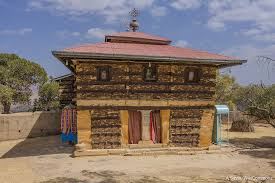Introduction
Have you ever wondered about the great civilizations of Africa that shaped history? The Kingdom of Axum, located in what is now Ethiopia and Eritrea, is one such ancient marvel. Flourishing between 100 CE and 940 CE, Axum was a powerful trading empire known for its monumental obelisks, adoption of Christianity, and advanced culture. Often overshadowed by civilizations like Egypt or Mesopotamia, Axum played a critical role in ancient history. Let’s dive into its fascinating story!
The Rise of the Kingdom of Axum

Geographical Advantage
Axum’s strategic location near the Red Sea and the Nile enabled it to control vital trade routes between Africa, Arabia, and the Mediterranean. This position laid the foundation for its rise as a trading powerhouse.
Founding and Early Growth
Axum’s roots can be traced back to the first millennium BCE. Initially a small kingdom, it expanded rapidly through trade, agriculture, and military conquests.
Trade and Economic Prosperity
A Thriving Trade Empire
Axum became a central hub for international trade, exporting goods like ivory, gold, and exotic animals while importing silk, spices, and wine from distant lands.
The Axumite Currency
Axum was one of the first African civilizations to mint its own currency. These coins, often inscribed with the names of rulers, reflect the kingdom’s economic sophistication and global connections.
Religion and Spirituality
Early Beliefs
Before Christianity, Axumites practiced polytheism, worshiping deities like Astar, Beher, and Medr. They also venerated their kings, who were believed to be divine.
Conversion to Christianity
In the 4th century CE, King Ezana converted to Christianity, making Axum one of the earliest nations to adopt the religion. This conversion marked a turning point, aligning Axum with the Christian world and leaving a lasting legacy on Ethiopian culture.
Also Read Generational Gap: Builders, Boomers, Millennials, Gen X, Gen Z, and Gen Alpha
The Architectural Marvels of Axum
The Stelae of Axum
One of the kingdom’s most famous features is its towering stone stelae. These obelisks, some reaching over 20 meters high, were intricately carved and served as markers for royal tombs.
The Church of St. Mary of Zion
Axum is also home to the Church of St. Mary of Zion, which, according to Ethiopian tradition, houses the Ark of the Covenant. This site remains a significant pilgrimage destination.
The Kingdom’s Political Structure
Monarchical System
Axum was ruled by a king who held absolute power. The title “Negus” or “King of Kings” underscored the ruler’s divine authority.
Administration and Diplomacy
The Axumites maintained strong diplomatic ties with neighboring empires, including the Byzantine Empire. These relationships were crucial for sustaining trade and cultural exchange.
Axum’s Role in Global History
Connection to the Roman Empire
Axum’s trade routes linked it to the Roman Empire, facilitating cultural and economic exchanges. Axumite coins often bore Greco-Roman symbols, reflecting this connection.
Influence on Neighboring Cultures
Axum played a vital role in shaping the cultures of neighboring regions, including the Arabian Peninsula. Its trade and religious practices influenced societies far beyond its borders.
The Decline of the Kingdom of Axum
Environmental Challenges
Deforestation and soil erosion are believed to have contributed to Axum’s decline. The kingdom’s reliance on agriculture made it vulnerable to environmental degradation.
Shifts in Trade Routes
The rise of Islamic empires in the 7th century CE diverted trade routes away from Axum, leading to economic isolation and weakening its power.
Legacy of the Kingdom of Axum
Cultural Influence
Axum’s legacy lives on in Ethiopia’s religious practices, languages, and traditions. The Ethiopian Orthodox Church traces its roots to Axum, and the Ge’ez script remains in use today.
Recognition as a UNESCO Site
The ruins of Axum were designated a UNESCO World Heritage Site in 1980, highlighting the kingdom’s historical and cultural significance.
Lessons from Axum
Trade as a Catalyst for Growth
Axum’s success underscores the importance of trade in building powerful civilizations. Its strategic location allowed it to thrive for centuries.
Adaptability and Innovation
From minting coins to adopting Christianity, Axum demonstrated an ability to innovate and adapt, securing its place in history.
Respecting the Environment
Axum’s decline serves as a reminder of the long-term impacts of environmental neglect, a lesson still relevant today.
Why Axum Matters Today
Axum is more than an ancient kingdom; it’s a symbol of Ethiopia’s enduring resilience and cultural richness. By studying Axum, we gain insights into the interconnectedness of ancient civilizations and the vital contributions of Africa to global history.
Preserving Axum’s Heritage
Modern Archaeology
Ongoing excavations continue to reveal more about Axum’s history, from its architectural techniques to its trade networks.
Cultural Pride
Axum remains a source of national pride for Ethiopians, representing a golden age of unity, innovation, and cultural achievements.
Conclusion
The Kingdom of Axum stands as a testament to the ingenuity and influence of ancient African civilizations. Its achievements in trade, architecture, and religion have left an indelible mark on history, shaping Ethiopia’s identity and inspiring the world. As we uncover more about Axum, we’re reminded of the enduring power of human creativity and resilience.
Also Read: How to Make Money Online With E-Commerce: Digital Success
FAQs
1. What was the Kingdom of Axum?
The Kingdom of Axum was an ancient civilization in modern-day Ethiopia and Eritrea, known for its trade, monumental architecture, and early adoption of Christianity.
2. What were Axum’s main achievements?
Axum was renowned for its thriving trade empire, towering stone stelae, minting its own currency, and becoming one of the first nations to adopt Christianity.
3. Why did the Kingdom of Axum decline?
Axum declined due to environmental degradation, shifts in trade routes, and the rise of Islamic empires, which isolated it economically.
4. What is the significance of Axum’s stelae?
Axum’s stelae are monumental obelisks that marked royal tombs. They are considered architectural marvels and symbols of Axum’s cultural sophistication.
5. Why is the Kingdom of Axum important today?
Axum’s legacy continues to shape Ethiopian culture and history. Its contributions to trade, religion, and architecture highlight the global significance of ancient African civilizations.


